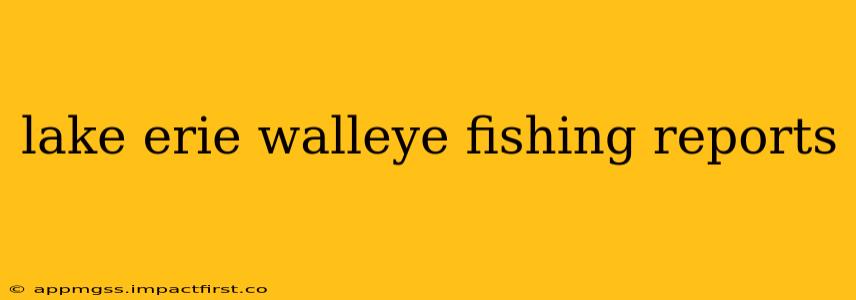Lake Erie is renowned for its excellent walleye fishing, attracting anglers from across the continent. But with such a vast expanse of water, knowing where to fish and what to expect can be challenging. This comprehensive guide provides up-to-the-minute information on Lake Erie walleye fishing reports, along with essential tips to maximize your success. We'll cover key areas, preferred techniques, and factors influencing the bite, ensuring you’re well-prepared for your next fishing trip.
Where are the Walleye Biting in Lake Erie Right Now?
This is the million-dollar question! Unfortunately, there's no single, definitive answer. Walleye movements are influenced by water temperature, prey fish availability, and spawning patterns. To find the most up-to-date information, you need to consult several resources:
- Local Fishing Reports: Check online forums, fishing websites (like those dedicated to Ohio, Pennsylvania, New York, or Ontario fishing, depending on the area of Lake Erie you're targeting), and social media groups specific to Lake Erie anglers. These often feature real-time reports from fellow anglers, detailing successful spots and techniques.
- Charter Captain Reports: Many charter fishing captains in Lake Erie areas actively update their websites or social media pages with their recent catches and fishing conditions. These reports are invaluable, as captains are constantly on the water, gathering firsthand knowledge.
- Ohio DNR, Pennsylvania Fish and Boat Commission, New York DEC, and Ontario MNRF Websites: These government agencies often publish fishing reports and advisories, providing information on fish stocking, water conditions, and regulations.
Remember that fishing conditions can change rapidly on Lake Erie. What's hot today might be cold tomorrow. Always check the latest reports before heading out.
What are the Best Techniques for Walleye Fishing on Lake Erie?
Lake Erie walleye fishing employs various techniques, depending on the season and location. Popular methods include:
- Trolling: This is a highly effective method, particularly for covering large areas. Trolling involves dragging lures behind a moving boat. Common lures include crankbaits, spoons, and planer boards. Depth and speed are crucial factors for success.
- Casting: Casting is ideal for targeting specific areas, such as weed beds or drop-offs. Jigging with soft plastics or casting crankbaits are popular choices.
- Vertical Jigging: This technique involves dropping jigs vertically to the lake bottom and slowly retrieving them. It's particularly effective in deeper waters or around structure.
What Depth Should I Fish For Walleye on Lake Erie?
Walleye depth preferences vary depending on the season and water temperature. In general:
- Spring: Walleye often stage in shallower water for spawning, usually in 10-20 feet of water.
- Summer: As the water warms, walleye move to deeper, cooler water, typically in 20-60 feet, seeking cooler temperatures and oxygen levels. They often relate to structure like reefs and drop-offs.
- Fall: As the water cools, walleye may again move into shallower water to feed before winter.
What are the Best Lures for Lake Erie Walleye?
The best lures depend heavily on water clarity, depth, and walleye behavior. However, some consistently productive options include:
- Crankbaits: These versatile lures mimic the movement of baitfish. Choose colors that match the local forage.
- Spoons: These reflective lures attract walleye with their flashing action.
- Soft Plastics: These highly versatile lures can be fished with jigs or weighted hooks, allowing for adjustment in depth.
- Live Bait: Occasionally using live bait such as minnows can be exceptionally effective.
Experimentation is key! Try different colors and styles until you find what works best.
What Time of Day is Best for Walleye Fishing on Lake Erie?
While walleye can be caught throughout the day, dawn and dusk often offer the most productive fishing. These low-light conditions can trigger increased feeding activity.
What is the Best Time of Year for Walleye Fishing on Lake Erie?
The best time of year is subjective, depending on your preferences. Spring and fall often offer excellent opportunities, while summer fishing can be highly productive in deeper water. Consult fishing reports for the most up-to-date seasonal information.
What are the Regulations for Walleye Fishing on Lake Erie?
Fishing regulations vary by state and province. It is crucial to check the specific regulations for the area you plan to fish before your trip. These regulations will detail daily limits, size restrictions, and licensing requirements. Consult the relevant government agency websites mentioned earlier to ensure you comply with all rules and regulations. Remember that responsible angling practices are essential for the long-term health of the Lake Erie walleye population.
By utilizing these tips and staying updated on the latest Lake Erie walleye fishing reports, you'll significantly increase your chances of a successful and enjoyable fishing experience. Tight lines!
